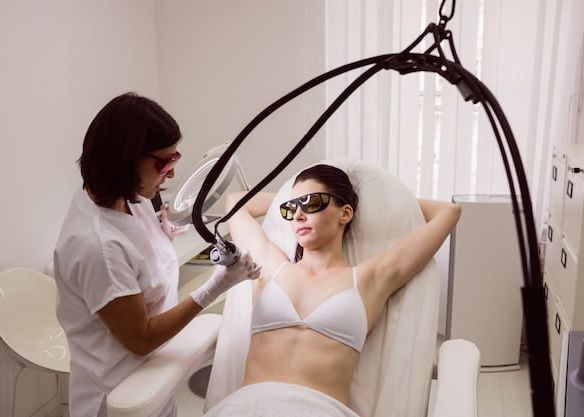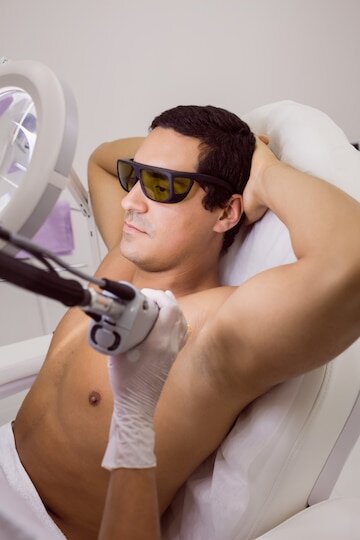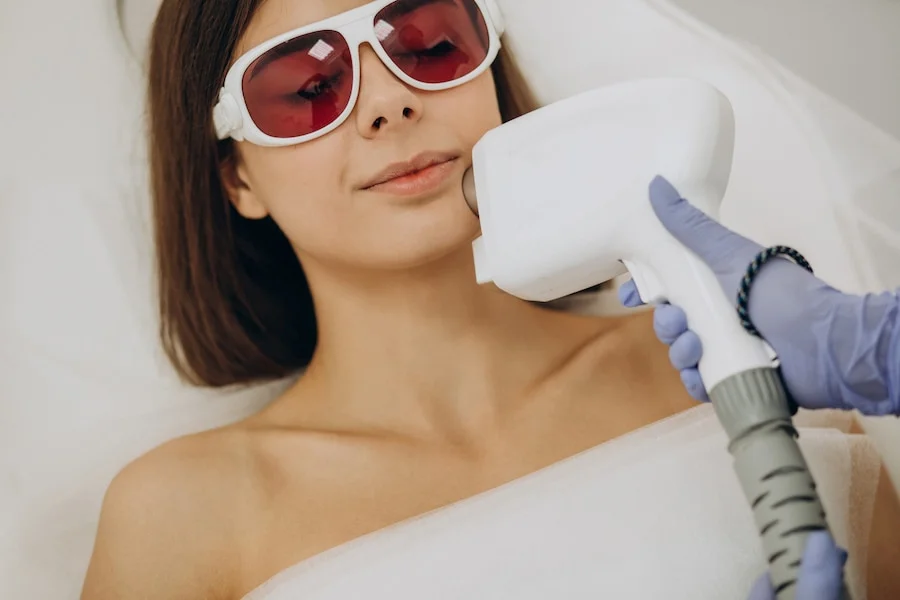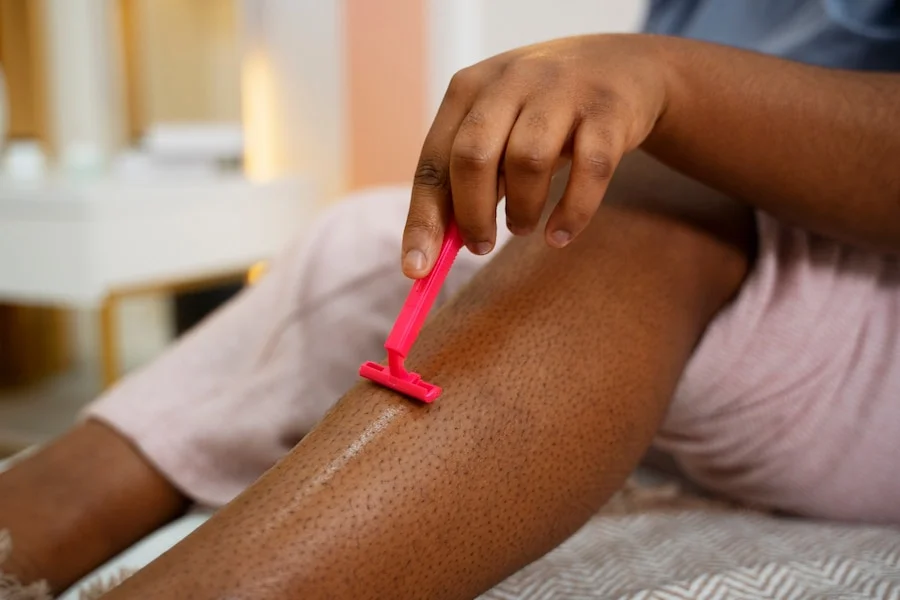Laser hair removal is a technique that uses powerful beams of light to stop hair growth by targeting the hair follicles.
Unlike shaving or waxing, which offer temporary solutions, laser hair removal provides a more permanent way to get rid of unwanted hair.
To make the most informed decision about laser hair removal, it’s important to understand the different types of laser systems available and their unique benefits.
Let’s take a closer look at Alexandrite lasers and why they stand out in the world of laser hair removal.
Table of Contents
ToggleWhat is Laser Hair Removal?
Laser hair removal utilizes concentrated beams of light to target and disable hair follicles. The laser energy is absorbed by melanin, the pigment in hair, damaging the follicle and hindering future hair growth.
This minimally-invasive procedure offers a more permanent solution compared to traditional hair removal methods like shaving, waxing, or tweezing.
Read our other article about laser hair removal and how it works.
Related: Does Laser Hair Removal Ruin Tattoos (+3 key Tips For Better & Safe Results)
Types of Laser Hair Removal Systems
Alexandrite lasers are a popular choice for laser hair removal, but with various technologies available, understanding their strengths and weaknesses compared to others is crucial.
Let’s explore some common laser hair removal systems and how they stack up against Alexandrite:

Ruby Laser:
The first laser used for hair removal, Ruby lasers emit a shorter wavelength (694nm) than Alexandrite (755nm). This makes them more suitable for very fair skin tones (phototypes I-III) with dark hair.
However, their gentler approach comes at the cost of speed, as they require a longer pulse duration and treat smaller areas.
Nd:YAG Laser:
This laser offers a distinct advantage – it can treat a wider range of skin tones, including darker complexions (phototype V).
It achieves this by targeting a different molecule in the skin (chromophore) than melanin, making it a safe option for individuals who may not be suitable for Alexandrite or other melanin-targeting lasers.
Diode Laser:
A more recent innovation, Diode lasers offer several benefits. They utilize a longer wavelength (800-810nm) that penetrates deeper than Alexandrite, making them effective for coarse hair.
Additionally, Diode lasers are generally safe for darker skin tones (up to phototype IV).
IPL (Intense Pulsed Light):
While not a true laser, IPL utilizes broad-spectrum light pulses to achieve hair removal.
Unlike lasers with a single wavelength, IPL offers customizable settings for wavelength, energy level, and pulse duration.
This flexibility allows for treatment of various hair and skin types, but the effectiveness may not be as strong as some lasers.

How Alexandrite laser works
In comparing laser hair removal options, Alexandrite lasers strike a good balance between getting the job done effectively and safely.
They work well for people with skin tones ranging from light to olive (phototypes I-IV), which means they’re more versatile than Ruby lasers but not as suitable for the deepest skin tones as Nd:YAG lasers.
When it comes to how quickly they can treat an area and how much skin they can cover at once, Alexandrite lasers are pretty speedy.
They have a larger spot size, so they can cover broader areas more efficiently than Ruby lasers and IPL machines, which often require more time for smaller zones.
In terms of the kind of hair they can handle, Alexandrite lasers are really good at targeting dark, coarse hair, similar to Diode lasers.
IPL may not be as effective with very coarse hair, though. So, overall, Alexandrite lasers are a solid choice for laser hair removal, offering both speed and effectiveness across different skin tones and hair types.
Related: Cynosure’s Elite iQ: The Life-Changing Laser Hair Treatment
How Effective is the Alexandrite Laser Hair Removal?
When considering options for hair removal like alexandrite laser and IPL (Intense Pulsed Light), it’s essential to weigh factors such as skin type, hair color, and treatment goals. Recent research has compared the effectiveness of these methods.
One study looked at how well the long-pulsed alexandrite laser and IPL worked for removing underarm hair in Korean women.
They studied 13 women with skin types III to IV, treating one side of their underarms with the alexandrite laser and the other with IPL over three sessions.
They found that the alexandrite laser was more effective at reducing hair (96% reduction) compared to IPL (86%) eight weeks after the last treatment.
Although the alexandrite laser caused a bit more discomfort, patients were more satisfied with the results.
While one person experienced a temporary burn from the alexandrite laser, both methods overall worked well and were safe, especially for people with darker skin tones.
So, while IPL might be cheaper per session, studies suggest that the alexandrite laser is more effective at removing hair, particularly for those with darker skin (skin type III – IV).
However, it’s important to consider your preferences, skin characteristics, and budget before deciding on a treatment.
Related: Laser Hair Removal And Dark Skin: What You Need To Know

Benefits of Alexandrite Laser Hair Removal
The Alexandrite laser stands out in the realm of laser hair removal for a couple of key reasons. Firstly, its ability to provide faster treatment times sets it apart from other systems like the Ruby laser.
With a larger spot size and quicker repetition rate, Alexandrite lasers can cover larger areas in less time, making the treatment process more efficient and convenient for patients.
Secondly, Alexandrite lasers are effective across a wider range of hair and skin tones, particularly excelling with light to olive skin tones (classified as phototypes I-IV) with dark, coarse hair.
While Nd:YAG lasers may address darker skin tones, Alexandrite lasers strike a balance between speed and effectiveness, making them suitable for the most common skin and hair types.
Limitations of Alexandrite Laser Hair Removal
While Alexandrite lasers offer both speed and effectiveness, it’s important to note their limitations. Primarily, they are most suitable for individuals with light to olive skin tones (classified as phototypes I-IV).
However, for those with darker skin tones (phototype V), there’s a heightened risk of side effects such as hyperpigmentation (darkening) due to the laser’s targeting of melanin. In such cases, Nd: YAG lasers present a safer alternative.
Another consideration is pain tolerance. The rapid repetition rate of Alexandrite lasers may result in a more uncomfortable treatment experience compared to other laser types.
While topical numbing creams or cooling devices can help alleviate discomfort, some individuals may find Alexandrite lasers less tolerable than Diode lasers, for instance.
At Dr. Lian Beauty, we utilize the Cynosure Elite iQ dual-length laser, which combines both Nd:YAG and Alexandrite technologies.
This advanced system features a built-in cooling system designed to effectively manage discomfort during treatment, ensuring a more comfortable experience for our patients.
Ideal Candidates for Alexandrite Laser Hair Removal
Before undergoing laser hair removal, there are several factors to consider for optimal results and safety.
While no harm to the unborn baby has been linked to the procedure, it’s generally recommended to avoid it during pregnancy due to hormonal fluctuations.
Similarly, breastfeeding may impact hair growth patterns, reducing the treatment’s effectiveness.
Certain medical conditions may also require caution. Individuals with psoriasis, bleeding disorders, or vitiligo should consult a laser practitioner to determine suitability for treatment.
Medications and sun exposure can also affect the outcome.
Relate: Understanding Sunburn: Types, Risks, Prevention and Treatment
Some medications increase sun sensitivity, while a tan can lead to uneven pigmentation, hindering laser effectiveness.
Consulting a healthcare provider can help determine the best course of action.
Skin tone plays a role as well. While laser hair removal works for all skin types, adjustments may be needed for darker complexions.
Alexandrite lasers are ideal for light to olive tones, while Nd:YAG lasers offer a safer option for darker skin.
Additionally, some skin conditions like keloid scars, lesions, or open wounds might require postponing treatment until the skin heals completely.
Other considerations include tattoos, recent waxing/plucking, epilepsy, and hirsutism.
Conclusion: Is Alexandrite Laser Hair Removal Right for You?
Alexandrite laser hair removal offers a safe and effective solution for achieving long-lasting hair reduction.
It’s particularly well-suited for individuals with light to olive skin tones and dark, coarse hair.
However, individual suitability can vary. Consulting a qualified medical aesthetician like those at Dr. Lian Beauty in Ottawa is crucial to determine if Alexandrite laser hair removal is the right choice for you.
They can assess your skin type, hair color, and medical history to create a personalized treatment plan that delivers optimal results with minimal risks.
So, if you’re tired of unwanted body hair and are seeking a long-term solution, schedule a consultation with a qualified professional to discuss Alexandrite laser hair removal and explore if it can help you achieve smooth, hair-free skin.
Would you like to learn more about Alexandrite laser hair removal and how Dr. Lian Beauty can help you achieve your desired results?
Quick Links

Dr. Lian Peter, MD, MPH, CCFP, is a Family physician with a passion for aesthetics. In her aesthetic clinic, she provides a wide range of minimally invasive and non-invasive procedures, constantly honing her skills to deliver exceptional care and help patients attain their desired appearance.





